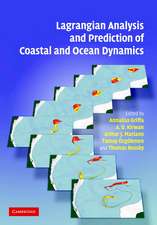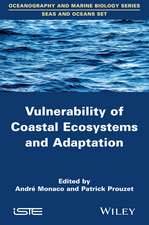Submarine Mass Movements and Their Consequences: 5th International Symposium: Advances in Natural and Technological Hazards Research, cartea 31
Editat de Yasuhiro Yamada, Kiichiro Kawamura, Ken Ikehara, Yujiro Ogawa, Roger Urgeles, David Mosher, Jason Chaytor, Michael Strasseren Limba Engleză Paperback – 23 aug 2016
This volume consists of the latest scientificresearch by international experts in geological, geophysical, engineering and environmental aspects of submarine mass failure, focused on understanding the full spectrum of challenges presented by submarine mass movements and their consequences.
| Toate formatele și edițiile | Preț | Express |
|---|---|---|
| Paperback (1) | 1074.94 lei 38-44 zile | |
| SPRINGER NETHERLANDS – 23 aug 2016 | 1074.94 lei 38-44 zile | |
| Hardback (1) | 1244.08 lei 6-8 săpt. | |
| SPRINGER NETHERLANDS – 29 sep 2011 | 1244.08 lei 6-8 săpt. |
Din seria Advances in Natural and Technological Hazards Research
- 18%
 Preț: 977.97 lei
Preț: 977.97 lei - 18%
 Preț: 921.15 lei
Preț: 921.15 lei - 18%
 Preț: 1406.35 lei
Preț: 1406.35 lei - 18%
 Preț: 788.72 lei
Preț: 788.72 lei - 15%
 Preț: 643.84 lei
Preț: 643.84 lei - 18%
 Preț: 955.56 lei
Preț: 955.56 lei - 18%
 Preț: 954.31 lei
Preț: 954.31 lei - 18%
 Preț: 958.56 lei
Preț: 958.56 lei - 18%
 Preț: 937.56 lei
Preț: 937.56 lei - 18%
 Preț: 952.72 lei
Preț: 952.72 lei -
 Preț: 382.18 lei
Preț: 382.18 lei - 15%
 Preț: 647.92 lei
Preț: 647.92 lei - 18%
 Preț: 948.47 lei
Preț: 948.47 lei - 15%
 Preț: 640.06 lei
Preț: 640.06 lei -
 Preț: 407.01 lei
Preț: 407.01 lei - 15%
![Submarine Mass Movements and Their Consequences [With CDROM]](https://i4.books-express.ro/bs/9781402012440/submarine-mass-movements-and-their-consequences-with-cdrom.jpg) Preț: 604.37 lei
Preț: 604.37 lei - 15%
 Preț: 643.48 lei
Preț: 643.48 lei - 15%
 Preț: 648.05 lei
Preț: 648.05 lei - 18%
 Preț: 1236.99 lei
Preț: 1236.99 lei - 18%
 Preț: 947.35 lei
Preț: 947.35 lei - 18%
 Preț: 947.35 lei
Preț: 947.35 lei - 18%
 Preț: 966.15 lei
Preț: 966.15 lei - 15%
 Preț: 642.51 lei
Preț: 642.51 lei - 18%
 Preț: 951.29 lei
Preț: 951.29 lei - 18%
 Preț: 1255.16 lei
Preț: 1255.16 lei - 15%
 Preț: 642.51 lei
Preț: 642.51 lei - 15%
 Preț: 646.43 lei
Preț: 646.43 lei - 15%
 Preț: 635.96 lei
Preț: 635.96 lei - 18%
 Preț: 1244.08 lei
Preț: 1244.08 lei
Preț: 1074.94 lei
Preț vechi: 1414.39 lei
-24% Nou
Puncte Express: 1612
Preț estimativ în valută:
205.68€ • 215.33$ • 170.19£
205.68€ • 215.33$ • 170.19£
Carte tipărită la comandă
Livrare economică 01-07 aprilie
Preluare comenzi: 021 569.72.76
Specificații
ISBN-13: 9789401778145
ISBN-10: 9401778140
Pagini: 769
Ilustrații: XXXI, 769 p.
Dimensiuni: 155 x 235 mm
Ediția:Softcover reprint of the original 1st ed. 2012
Editura: SPRINGER NETHERLANDS
Colecția Springer
Seria Advances in Natural and Technological Hazards Research
Locul publicării:Dordrecht, Netherlands
ISBN-10: 9401778140
Pagini: 769
Ilustrații: XXXI, 769 p.
Dimensiuni: 155 x 235 mm
Ediția:Softcover reprint of the original 1st ed. 2012
Editura: SPRINGER NETHERLANDS
Colecția Springer
Seria Advances in Natural and Technological Hazards Research
Locul publicării:Dordrecht, Netherlands
Cuprins
Preface.- Section I: Physical Properties of Sediments and Slope Stability Assessment.- Section II: Seafloor Geomorphology for Trigger Mechanisms and Landslide Dynamics.- Section III: Role of Fluid Flow in Slope Instability.- Section IV: Mechanics of Mass Wasting in Subduction Margins.- Section V: Post-Failure Dynamics.- Section VI: Landslide Generated Tsunamis.- Section VII: Witnessing and Quasi-Witnessing of Slope Failures.- Section VIII: Architecture of Mass Transport Deposits/Complexes.- Section IX: Relevance of Natural Climate Change in Triggering Slope Failures.- Index.
Textul de pe ultima copertă
Submarine mass movements represent major offshore geohazards due to their destructive and tsunami-generation potential. This potential poses a threat to human life as well as to coastal, nearshore and offshore engineering structures. Recent examples of catastrophic submarine landslide events that affected human populations (including tsunamis) are numerous; e.g., Nice airport in 1979, Papua-New Guinea in 1998, Stromboli in 2002, Finneidfjord in 1996, and the 2006 and 2009 failures in the submarine cable network around Taiwan. The Great East Japan Earthquake in March 2011 also generated submarine landslides that may have amplified effects of the devastating tsunami. Given that 30% of the World’s population live within 60 km of the coast, the hazard posed by submarine landslides is expected to grow as global sea level rises. This elevated awareness of the need for better understanding of submarine landslides is coupled with great advances in submarine mapping, sampling and monitoring technologies. Laboratory analogue and numerical modeling capabilities have also developed significantly of late. Multibeam sonar, 3D seismic reflection, and remote and autonomous underwater vehicle technologies provide hitherto unparalleled imagery of the geology beneath the oceans, permitting investigation of submarine landslide deposits in great detail. Increased and new access to drilling, coring, in situ measurements and monitoring devices allows for ground-thruth of geophysical data and provides access to samples for geotechnical laboratory experiments and information on in situ strength and effective stress conditions of underwater slopes susceptible to fail. Great advances in numerical simulation techniques of submarine landslide kinematics and tsunami propagation, particularly since the 2004 Sumatra tsunami, have also lead to increased understanding and predictability of submarine landslide consequences.
This volume consists of the latest scientificresearch by international experts in geological, geophysical, engineering and environmental aspects of submarine mass failure, focused on understanding the full spectrum of challenges presented by submarine mass movements and their consequences.
This volume consists of the latest scientificresearch by international experts in geological, geophysical, engineering and environmental aspects of submarine mass failure, focused on understanding the full spectrum of challenges presented by submarine mass movements and their consequences.
Caracteristici
Unique subject that is addressed in very few other publications and interest is growing rapidly State of knowledge of submarine mass movements and their consequences Engineering and environmental considerations of submarine slope failures Tsunami potential of submarine mass movements








